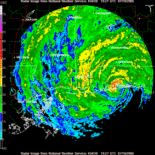Had this materialized, Frances would have very likely been near a borderline Category Four/Category Five at Florida landfall due to excellent diffluence and upper-level ridging support and a more southerly track, which also would have supported a landfall in metropolitan Broward/Palm Beach. Contrary to what some believe, mid-level dry air intrusion was likely only a very minor factor in Frances' weakening on September 2 and September 3 in the Bahamas, and in fact, the eyewall was showing signs of tightening per satellite (and even RECON to some degree) and there was NO evidence of ANY ERC at all. Frances was already finished with it's ERC on September 1, which was at least one day earlier. With all that said, east-central and southeast Florida (especially the metropolitan areas and vicinities) likely came VERY close to seeing a 935 millibars or lower (120KT or higher) hurricane making landfall. The SST environment and heat content from PR to the Bahamas - as well as the Gulf Stream - would have only further enhanced this.
I know it's still a rather moot point, as the storm was still quite destructive, but I just found this interesting to bring up, as I find it unusual that Frances' weakening isn't recalled as often verbally.
Here, for example, is a shot of Frances (IR) on September 2. If viewed on a loop, you would note how outflow was attempting to expand, even up to the time of this image, and you would note the lack of ANY sign of an ERC or significant concentric eyewalls. If anything, the shear was the only significant factor that kept an intensification phase from occurring on September 2 and September 3.

Note the middle to upper-level shear (associated from the aforementioned trough over the Carolinas) over Frances at the time of the image and over the next few days, resulting in the weakening phase to a Category Two. Also note the upper-level outflow support and strong upper-level anticyclonic ridge just to the east of Frances and edging over it. It is very clear that if the shear did not verify, the ridgingf and already extremely favorable environment would have been even more firmly entrenched over Frances and the Bahamas, resulting in a more southerly track into southeast Florida and an outstanding outflow support environment from north of the DR to Florida.
In short, what weakened Frances over the Bahamas was NOT outflow interaction with Cuba (the Great Miami Hurricane of 1926 which passed in the region of Frances did not find this detrimental), nor was it an ERC or even mid-level dry air (although it did play a very slight role). The culprit largely was mid-level shear. Period.
Just wanted to bring this up, since we are discussing the weakening of storms before landfall (including numerous recent GOM storms).




